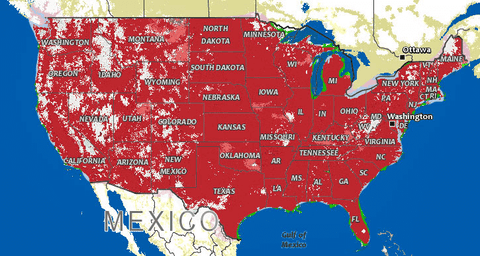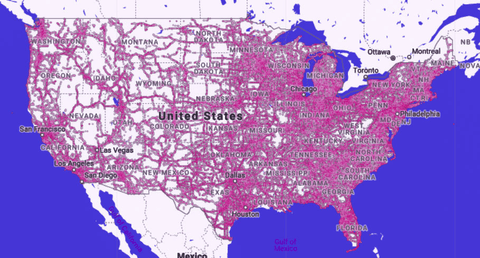Verizon Coverage Map and How to Boost Cell Phone Signal
Sep 05, 2019

Learn how to boost your Verizon Wireless signal in your home, office, or vehicle using our coverage maps and cell phone booster suggestions.
Verizon is one of the "big 4" cellular providers (AT&T, Sprint, T-Mobile, Verizon) operating right now in United States. Out of all of them, Verizon boasts the widest coverage on their networks, with around 70% 4G LTE coverage across the entirety of USA mainland (contiguous 48 states).
At the time of writing, whilst Verizon has the widest 4G coverage, AT&T and T-Mobile beat Verizon on 3G coverage size. But taken as a whole, with both 3G and 4G coverage accounted for, Verizon's mobile network is still undoubtedly the largest.
Verizon's 4G Coverage.
Of the top 4 providers, Verizon's 4G coverage map is the widest reaching by far. Their service supposedly reaches as much as 98% of the current US population, across more than 2.5 million square miles and 326 million people.

This coverage is undoubtedly impressive, but for most people, wide coverage shouldn't be a decisive factor in their choice of mobile and wireless coverage. Unless one frequently travels across the whole country, a wide spread coverage map is irrelevant. In those instances, one would be better served looking at coverage in the direct area where one lives, works, and drives to, over the weekend.
Verizon's 3G Coverage.
As already stated, Verizon's 3G coverage is lower than two of other big 4 providers.

However, with advent of 5G technology and the roll-out of higher capacity networks, it is predicted that 3G coverage is going to become quickly irrelevant, only being used when 5G and 4G coverage fails or is unavailable due to factors beyond carrier's control.
It is also worth noting that Verizon has recently confirmed that they will no longer activate 3G only phones going forward, with only phones that are 4G enabled allowed to activate on the network. This means that paying attention to Verizon's lower 3G coverage is now least relevant.
What Does the Red Coverage on Verizon's Coverage Maps Mean?
Looking at the map provided by Verizon, you will notice that it has incredibly wide coverage, and only few areas that aren't specifically covered by Verizon's 4G coverage. The coverage size is very impressive but the disclaimer stated on their website states one may not receive coverage as shown due to many factors including topography, building materials, bad weather, etc.
When accounting for their coverage, Verizon includes third party providers, or Mobile Virtual Network Operators (MVNO's) who operate using the Verizon network. By looking at the map alone, you can't tell which areas are covered by Verizon themselves on their own and which they share with their MVNOs. Verizon Wireless itself does not provide this information.
Total list of MVNO's by Network.
You will notice by looking down this list, that practically every MVNO operating in America works through the Verizon network, which is why they have such high levels of coverage across every single state.
| MVNO | Networks supplied |
| CREDO Mobile | Verizon |
| GreatCall | Verizon |
| Net10 | Verizon, Sprint, T-Mobile, AT&T, US Cellular |
| Page Plus | Verizon |
| Red Pocket | Verizon, Sprint, T-Mobile, AT&T, US Cellular |
| ROK Mobile | Verizon, Sprint |
| Straight Talk | Verizon, Sprint, T-Mobile, AT&T, US Cellular |
| Total | Verizon |
| TracFone | Verizon, Sprint, T-Mobile, AT&T, US Cellular |
| Twigby | Verizon, Sprint |
| US Mobile | Verizon, T-Mobile |
Verizon Coverage by State.
| State | Square Mile Coverage (miles²) | Percentage Area Covered (approx. %) |
| Alabama | 49529 | 95.00% |
| Alaska | 11428 | 2.00% |
| Arizona | 93810 | 82.00% |
| Arkansas | 52990 | 99.00% |
| California | 117504 | 74.00% |
| Colorado | 85156 | 81.00% |
| Connecticut | 4947 | 98.00% |
| Delaware | 2009 | 96.00% |
| Florida | 55258 | 94.00% |
| Georgia | 58409 | 99.00% |
| Hawaii | 5894 | 86.00% |
| Idaho | 53883 | 64.00% |
| Illinois | 53206 | 94.00% |
| Indiana | 34470 | 95.00% |
| Iowa | 51388 | 91.00% |
| Kansas | 82028 | 99.00% |
| Kentucky | 26662 | 66.00% |
| Louisiana | 45002 | 96.00% |
| Maine | 19818 | 59.00% |
| Maryland | 9960 | 91.00% |
| Massachusetts | 7927 | 94.00% |
| Michigan | 53778 | 90.00% |
| Minnesota | 74615 | 88.00% |
| Mississippi | 46719 | 97.00% |
| Missouri | 56438 | 81.00% |
| Montana | 83493 | 56.00% |
| Nebraska | 75936 | 97.00% |
| Nevada | 61795 | 55.00% |
| New Hampshire | 8147 | 84.00% |
| New Jersey | 7542 | 97.00% |
| New Mexico | 98347 | 81.00% |
| New York | 42705 | 87.00% |
| North Carolina | 46892 | 92.00% |
| North Dakota | 68393 | 97.00% |
| Ohio | 39764 | 96.00% |
| Oklahoma | 51645 | 73.00% |
| Oregon | 70472 | 72.00% |
| Pennsylvania | 42178 | 93.00% |
| Rhode Island | 1087 | 92.00% |
| South Carolina | 30821 | 98.00% |
| South Dakota | 74320 | 96.00% |
| Tennessee | 40673 | 96.00% |
| Texas | 243085 | 91.00% |
| Utah | 65286 | 78.00% |
| Vermont | 8646 | 89.00% |
| Virginia | 38050 | 93.00% |
| Washington | 44834 | 65.00% |
| West Virginia | 12650 | 52.00% |
| Wisconsin | 49834 | 87.00% |
| Wyoming | 78335 | 79.00% |
What this means for you?
For the common user, the fact that Verizon uses a wide list of MVNO's should make absolutely no difference.
Instead, look at individual coverage in your area, with figures available from the Verizon website here, in order to ascertain whether Verizon is right for you.
However, if you regularly travel across state, country, or outside USA, the fact that Verizon has wide coverage under more than a dozen networks could be far more of a factor.
It is also worth noting that coverage maps and figures like these are usually approximations, based on signal towers and strength. They do not generally take into account geographic factors or other signal interference.
Improve your Verizon signal strength if not strong enough in your home, office, or car.
If you notice weak signal strength or slow data speed, we can help! We offer cell phone signal boosters for Verizon Wireless that will save you time and money. Either try an easy product selection tool to find the right one (at prior link), or browse a variety of signal boosters for Verizon Wireless. The most economical Verizon cell phone booster starts at $299. No need to change your plan and pay more each month. The cell phone booster utilizes technology to boost your cellular signal and improve mobile data speed within your home, business, or car.
Share this post
12 comments


I’m in metro Detroit area and can only get one bar signal. I just drove across the USA and either had no service or only one bar of poor service. Took my phone into Verizon store and they replaced the SIM card, still only one bar of very slow service. I’m done with Verizon!
I don’t understand why Verizon has gaps in coverage all over the West Coast. Does anyone have any information on this? Also, are these gaps so widespread that even a signal booster won’t help? It’s surprising considering how Verizon advertises about its “nationwide coverage.”
How to get better signal for my house There should be no reason for where we live at that our signal should be this poor
I live in newport wa 99156 pend oreille county .we have a verizon tower close but the service for the last month or so has been awful was told verizon is pulling their service out of penoreille county .is that true I need to know so I can change to att
Why. Don’t I have. No. Signal. 15456
The problem with ALL cell providers is money. They only care about the densely populated areas because they get more money in those areas. None of them care about rural areas. I literally live 2 miles outside of the nearest town and have no service from verizon. They don’t care. I have complained so many times and they still don’t care. Or they want you to buy a cell signal booster for an ungodly amount of money. They should be able to provide the service you pay for and that’s it. So sick of companies charging for services you can’t use.
In my area I am suppose to get excellent signal but most times I am only getting 1-3 bar strength anywhere I go. I have a new phone so it’s not a phone issue. I switched from Virgin Mobile/Boost Mobile to Verizon because I thought Verizon would be better. Eventually it is not ! Very disappointed.
Verizon phone coverage is VERY sketchy in my area. The calls cut in and out constantly. Why don’t they offer satellite phones for rural America? OR just put in mini- towers in DEAD areas.
Verizon was in the landline biz so long it only seems appropriate they have the cell phone game locked down tight. I never liked Verizon when they ran my landline account so I’m biased against their organization. Some people might not give a care so they’re happy with the wide coverage. Not me. They were always raising my bill for no reason.
I have tried Verizon in the past and it was pretty good but was starting to fade later on. I am with AT&T now and it is the same as Verizon but they are the only ones in my area that has any service at all.I think we need more towers in the rural areas like where i live. It is our only means of communication. May have to go back to landline.
I’ve always liked Verizon. They have good customer service and affordable plans. I’ve had good experiences with their product too. There have been times I’ve had dropped calls and iffy voice reception, but never a chronic problem. The idea of having to buy something to make my phone work better i.e. less dropped calls, faster downloads, etc. never occurred to me, but I won’t rule it out. For now, I’m satisfied with Verizon and hope to be for some time to come.
This article is a real eye-opener for me. I never heard of Mobile Virtual Network Operators (MVNO’s) or how carriers rely on them to boost coverage. Obviously as this article mentions, most people need to focus on one thing—the coverage where they live rather than nationwide coverage (unless they’re a person that travels a lot for work or pleasure).